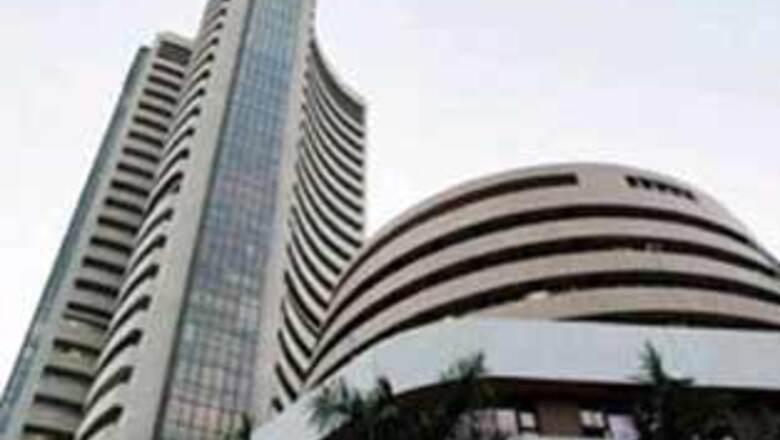
views
Samir Arora of Helios Capital said the current market rally is fuelled by short covering. He feels the rally may be sharp but may not last during elections. "The current rise can be more substantial than just a bear market rally. It is too early to say if this is beginning of a bigger bull run." According to Arora, poor technicals and elections could be key negatives for the market.
Speaking on the triggers for markets, R Sukumar of Franklin Templeton said elections could be one of the issues for market. However, he stressed that corporate performance is key. "Any positive surprises in earnings would have a bigger impact."
Here is a verbatim transcript of the exclusive interview with Samir Arora and R Sukumar on CNBC-TV18. Also watch the accompanying video.
Q:What do you think – it is one of those bear market rallies or is it something more substantial than that?
Arora: Well why not? Why can’t it be more substantial although in the beginning we will all have this assumption that it is bear market rally but my question is always been that either the market should lead us or corporate results should lead us. If the markets go up first we can think and imagine and reasonably so that the markets are discounting the future and are looking ahead or alternatively the markets may be flat and the corporate results are better, so we can say that the market is ignoring the current good results if they were good and therefore we should invest.
Right now the market is leading in some sense but look at the numbers that have come out recently. Yesterday Bank of America said that they will make USD 50 billion of pre-provisioning, pre-tax profits and their market cap currently is about USD 38 billion. People then say – the bearish guys say we don’t know what the provisions are. Let us say they are USD 50 billion, so Bank of America makes no profit for the whole year. Even then USD 38 billion market cap for the biggest bank having sort of crossed this event this year, so in general it can have more legs but today it is too early to say that whether it is a bigger bull or not but it will be meaningful in itself and therefore we have to take it one step at a time and in that sense this rally will be longer than just a day or two.
Q: What do you think – is it one of those bear market pullbacks or as Samir says, it may start with small steps but can go longer this time?
Sukumar: We will have to treat different markets differently. The economic fundamentals are going to be critical. In Asia my view is that from a valuation perspective we are close to a bottom and the economic fundamentals are going to be better. So I am willing to subscribe that we are probably closer to the bottom and so it is a good investment opportunity. The western world is going to be more difficult say with conviction that the bear market is over because the recession could be deep rooted and there could be a lot of corporate bankruptcies which might spoil the sentiment from time-to-time, so it might not be end of the bear market.
Q:What sense do you have of the FII outflows – year-to-date about a couple of billion dollars? Do you see that abating with some amount of stabilisation in the western markets or do you think that will remain a drag on the Indian market?
Sukumar: It could remain a drag for some more time because there are still a few investors who are pulling out money and there are some funds which have performance issues as well and it is possible that there could be redemptions in those funds whereas the ones which are performing well might not see similar amount of inflows. It is possible that the outflows might continue for sometime. But having said that the absolute value of outflows is going to diminish and from a demand supply point of view I suspect that in the second-half of 2009 it is going to be much better than what you have seen in the last 18 months or so.
Q: You’ve got a better sense of this sitting out there in Singapore. What to your mind has caused this USD 2 billion outflow this year from the FIIs? Do you see it ebbing after March or continuing like this?
Arora: In the beginning we got spooked by Satyam. I think the market performance decides these things because it is very easy to build a bullish or a bearish case on any thing you like. Right now the world is looking into a bearish thing because the market was leading us in that direction.
You may not get new inflows till elections are over. But as of now the expectation would be that in some form or the other you hope that a Congress led coalition leads. But the markets or the world will be still worried about that because in this case unlike in the past where we were to say that it does not matter which government comes into power. Right now it does matter that whether it is Congress/BJP or the Third Front. These are bipolar choices. I don’t think anybody in the financial world will accept a Third Front government.
So therefore as events have low probability but a high impact, it is possible that the real flows start after the elections are out of the way.
PAGE_BREAK
Q: In the past we have had these 8-10per cent kind of jerk-ups but they have been more by way of short covering, which have then not seen any good money follow up, both in the west and in India. Do you see it happening this time or essentially short covering being the only driver of the rally?
Arora: Right now it is short covering. But it is from such extreme levels and I could say they are manipulated levels. It is the same as in 2000 where you would announce that the price of a stock will be Rs 2,000 and it would become like that.
Right now you can see it – and you might know it as much as I do – that in many cases the kind of price targets that are put are basically just to lead the public into it. Say ICICI will be Rs 50 and this stock will be Rs 10, these are just things for the bears who have a position, and who just pile on. Therefore the reverse rallies or the pullbacks will be sharp.
The thing that I am saying is, if I want to be bullish today because the market is up I can say it. But in the end we still believe that Congress has a much higher probability or the Congress/BJP has a much higher probability than Third Front. So, how can I build my entire portfolio for a 20-30per cent probability scenario?
On the other hand, if the markets are down and I have no real incentive, I can say let it be, which is what the bears are piling on right now. Right now I don’t think that when they put these targets they can really justify them. They just put these targets, and because the momentum is in their favour it was working.
But just like you can take Bank of America or Citibank or any of these guys or do USD 1 in play for bankruptcy and still short – I mean people want to play for that last dollar in Citibank; they want to play for that last dollar here. So, what I am saying is that the rally could be sharp. It may or may not lead to a further rally and that depends on our own elections and of course on the world.
But right now the probability of losing much more in a 6-9 month scenario is not much more than 5-7 per cent. So what even between you see a mark-to-market loss?
Q: You have been hearing what Arora’s point on the elections. The fear in the market is that because we have got this domestic event we may not perform as well in line with other global markets even if global markets were to rally from here. Do you buy that point? Is the election such a big hangover for the next couple of months?
Sukumar: I believe it is one of the issues but there are going to be equally important issues. I think the corporate performance is going to be critical. Fortunately, expectations are pretty low. We are going to have a few disappointments and we are also going to have a few positive surprises. I think the positive surprises will have a bigger impact than negative ones because expectations are extremely low in terms of profits, corporate governance, and so on. I think the positive surprises could in my view have a bigger impact going forward. If that pulls up the market, I think there will be a serious covering by the bears and that might sustain the rally for quite some time.
If that were to synchronize with the rest of Asia, I think we could have a much better market for quite sometime.
Q: What do you think because the bearish case is that there is still going to be negative earnings surprises in the course of the next couple of quarters? Do you think that may not happen, that is fully priced in? Is it simply poor technicals and bad sentiment which is keeping the markets at these levels?
Arora: I think it is poor technicals and politics. You could have postponed the politics issue for another month if you wanted. If you had better technicals, you could have said we still have two months left, you can always worry about in the last month. But the problem right now is that this is for the first time at least in the last 8-10 years or maybe more, that you actually have extreme scenarios. Although the probability previously I thought would be 10per cent, from media reports all that looks a bit scary so you may add another 10per cent. The case for India would become very bad if the outcome of politics is not good. Therefore, somebody new to investing in India would get more nervous whereas the old guy themselves have not been showing great encouragement
But in general my bullishness came from the fact that in the last few months and I think that people were worried that India is not following through on the global theme. But that is because this week itself when US markets rallied, India was close for those two days. In that sense, India was reacting more to global events than local, but underperforming initially because of maybe Satyam, later on because fiscal numbers came out much worse, and then now elections. Right now, I would say that it is not as strong as it would be if we did not have the political overhang.
PAGE_BREAK
Q: I want to ask you about banks, they have participated most in this pullback rally of the last couple of days because they were beaten down the most. Do you think they were irrationally beaten down or unjustifiably so or do you subscribe to the same concerns which the market has been speaking about in beating them down?
Sukumar: I think if you are looking as a sector, it might not be totally irrational because the bad news takes some time to emerge in the banking system. There is first the deterioration in the fundamentals of the manufacturing sector or other services sector and then we have some bankruptcies etc and then the balance sheet of banks worsen. So, the deterioration happens later in the cycle compared to the rest of the market and that is one of the reasons why you have a second bout of underperformance of the banking sector. It is not going to affect each and every bank equally. The quality of risk control and credit analysis differs from bank to bank and there are some banks which have been probably punished more than what they should be. They could pullback sharply and sustain a rally, whereas the others which have seen a temporary improvement and might languish for some time if the balance sheet of those banks continue to deteriorate.
Q: You have been bullish on the private sector financial space. Were you a bit taken aback at the ferocity at which they were beaten down over the last four weeks? Do you think it is done now or was it overdone?
Arora: It was overdone, but in the last few months we have reduced our holding of private sector banks only primarily to HDFC Bank. We will stick with it in all situations. But banks or otherwise, the sort of one way reaction was overdone. In the end if we find out now that one big hedge fund investor had its own issues and therefore sold millions and millions of state-owned banks to make it into some big picture view on India and Indian banks is a bit overdoing it.
But in general if Indian banks today now show little higher NPLs and for that they are supposed to react, that again is an extreme situation because banks fell well before any of these problems came up. So, who is to say that we don’t look ahead one year and look at only events that are happened concurrent to market movement.
I think in general they have been hit enough and they are in many cases better corporate governance, better dynamics, better relative to the world in terms of the same sector view, but if the rally in the world is going to be now coming because of either short covering or a change of view on financials then Indian financials will do well whether we have our current problems or not just like they performed badly last year because the rest of the world’s financials were doing badly without having their own problems at that time.
Q: Do you see these individual incidents happening that is the question I was asking you earlier about the poor technicals – one institution had to sell public sector banks, one institution was dumping private sector, one institution sold quite a bit of FMCGs and these stocks were all brought down to their knees – do you see this individual kind of incidents happening going forward too?
Arora: We in the past were not tracking these things so much but now if you look at least for the midcap names what is the foreign ownership and see that it is not very higher than that – it is good point to see, which previously we were ignoring ourselves. So I won’t know but right now it has become a question at least for the midcaps names to slightly below the largecap names as to what is the FII ownership and what was it at the peak and if it is down meaningfully then you feel okay that some of that pressure may be off.
But this is too difficult to track who will have the next problem. All I am saying is it is a bit unfair for us to start justifying that thing and say yes we deserve this. Sometimes we don’t, it is just the problem of the investor rather than of the investment.
Q: I want ask you about the autos next because that’s a sector we have not spoken about. The last two-years it was the biggest dog in the market. There are some signs of hope in some of these stocks. As a fund manger, would you have started re-weighting or re-looking at your weightage on autos? Do you think the worst is over?
Sukumar: There are three distinct segments within autos. One is commercial vehicles, so we are coming close to the bottom of the cycle there and there is case for saying that at the bottom of the cycle you can find value but there are some commercial vehicle companies which have overextended their balance sheet because of problems with their corporate strategy and there might not be recovery in such cases. In motorcycles, I think anyway those stocks have outperformed substantially over the last year or so. They might provide steady returns, I don’t see a huge outperformance going forward and then we have passenger cars and we have only one credible company listed there. I am not too bullish on that segment because competition will intensify in the medium-term though it might have abated from a short-term perspective and that might put pressure on market share and margins over the medium to long-term there.
Q: The other point is the rupee flirting around the 52 mark. Is that causing some trepidation for your part of the woods?
Arora: Yes, that one has been a big pain this year again. Although last year we were very poor in reacting to it, this year we have hedged quite a bit of our rupee at 52. So, beyond 52 we will not lose. But up to 52, which is about 1per cent away we are still fully exposed to the rupee.
But the rupee has been a big negative in terms of attracting or even explaining the performance of India. The only thing you can say there is it is dollar related. All the institutional guys agree that in a longer-term scenario the dollar cannot be so strong. But in the short-term it has been painful. Finally we have also thrown in the towel and hedged ourselves primarily across the election period. After that we will have to buy new protection there.
Q: How are you positioning yourself in your portfolio in India right now? I just heard that you have exited most banks barring HDFC Bank. But given your view on this market, how have you positioned yourself for the next 3-6 months?
Arora: We have reduced our net quite a bit. Our net is now about 22-23per cent, which is about 55 long, 30 short. So, in that 55, the new stocks that we have bought; we have not bought 3per cent kind that we normally used to do. We bought 1-1.5per cent in five or six new names and reduced some outright.
Basically, the idea was to reduce the gross book rather than have a big long and a big short because that has also been very difficult. So, we have just reduced the gross size of the portfolio to 55 or so long and about 30 short.
Q: If banking has been reduced as your big bet other than infrastructure, what have you increased exposure to on the long side?
Arora: Since December we bought two autos, and even two consumers finally, we bought the liquor guys. We bought a few other companies. But broadly the consumer still is only about 1.5per cent. So, it is not a big deal.
But in general we have moved to these stocks and the rest we have just sold outright and forgotten about them. For the moment, it is primarily to go across the election. Right now with 20-30per cent exposure if you can perform a little better to get 40per cent of the market then it is okay, if you can protect on the downside.
Q: Did I hear you correctly, did you say autos? I don’t think you have ever owned autos, have you?
Arora: Yes. In my Alliance days, actually I was a very big holder of Hero Honda from 2001 in Alliance. That is the one that we bought in December or I think early January.

















Comments
0 comment